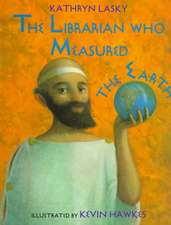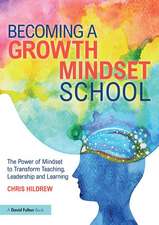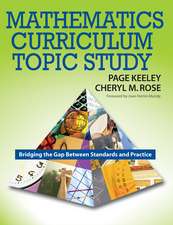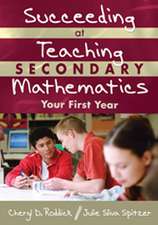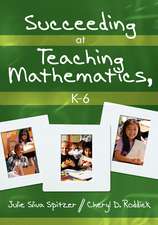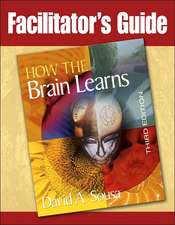How the Brain Learns Mathematics
Autor David A. Sousaen Limba Engleză Paperback – 14 ian 2015
This updated bestseller takes readers to the next level with new brain-friendly strategies backed by the latest research and even more ways to seamlessly incorporate what you learn about your students’ developing minds into your math classroom. Discover the cognitive mechanisms for learning math, explore factors that contribute to learning difficulties, and follow a four-step teaching model that relates classroom experience to real-world applications. Features include:
- New strategies for motivating adolescents
- Integration of the arts into mathematics instruction
- New information on how technology affects attention and memory
- Expanded sections on number sense and ELL instruction
- More than 160 new references
Preț: 311.35 lei
Nou
Puncte Express: 467
Preț estimativ în valută:
59.58€ • 61.98$ • 49.19£
59.58€ • 61.98$ • 49.19£
Carte disponibilă
Livrare economică 24 martie-07 aprilie
Livrare express 08-14 martie pentru 46.12 lei
Preluare comenzi: 021 569.72.76
Specificații
ISBN-13: 9781483368467
ISBN-10: 1483368467
Pagini: 256
Dimensiuni: 216 x 279 x 17 mm
Greutate: 0.7 kg
Ediția:Second Edition
Editura: SAGE Publications
Colecția Corwin
Locul publicării:Thousand Oaks, United States
ISBN-10: 1483368467
Pagini: 256
Dimensiuni: 216 x 279 x 17 mm
Greutate: 0.7 kg
Ediția:Second Edition
Editura: SAGE Publications
Colecția Corwin
Locul publicării:Thousand Oaks, United States
Recenzii
"Teaching mathematics without having read How the Brain Learns Mathematics is like trying to master tennis without a coach. Sousa's book is a tour de force: It builds a solid bridge from cognitive neuroscience to daily classroom practice. Every teacher of mathematics will benefit from this well-researched, well-organized, thoughtful, and practical approach to making math instruction align with how brains learn."
“David Sousa’s How the Brain Learns Mathematics, Second Edition is a wonderfully readable presentation of how neuroscience and cognitive psychology can inform the teaching of mathematics in elementary and secondary schools. Sousa engages his readers intellectually with recent research on the brain and mathematics learning, and avoids pat answers where the evidence is suggestive rather than conclusive. The book should be a valuable text for teachers who want a deeper insight into thinking processes behind the learning and teaching of math.”
“David Sousa has done it again! He has produced a highly-relevant, exceptionally practically, research focused book that will build better mathematics brains in classrooms and schools.”
“Sousa nailed it with these powerful insights on mathematics instruction. Teachers simply have to understand how students learn in order to provide top-notch instruction, and the specific teaching suggestions herein are invaluable! I love the three tier structure, emphasizing differences in teaching Pre-K and K, Pre-adolescent brains, and adolescent brains, and the emphasis on number sense at all levels is essential in the classroom today. Math teachers will apply these critical lessons immediately in their classes, and I’d urge every mathematics teacher and every elementary teacher to get this book!”
From a review in NCTM’s Mathematics Teaching in the Middle School:
“Classroom teachers, administrators, and math coaches will appreciate the research-based explanations for why mathematics instruction that focuses on meaning making, connections, and processes is so important.”
“Few other books discuss the scientific way the brain is mathematically wired while maintaining relevance to those interested in K–grade 12 education. Readers can expect to gain a deeper understanding of why students learn certain concepts easily and struggle with others and why the battle for successful student learning in mathematics is ever-changing. This book is not merely a collection of lesson plans and activities; it is also a deeper investigation into the science of mathematical learning and inspires readers to continue their own learning into the fascinating world of education.”
“David Sousa’s How the Brain Learns Mathematics, Second Edition is a wonderfully readable presentation of how neuroscience and cognitive psychology can inform the teaching of mathematics in elementary and secondary schools. Sousa engages his readers intellectually with recent research on the brain and mathematics learning, and avoids pat answers where the evidence is suggestive rather than conclusive. The book should be a valuable text for teachers who want a deeper insight into thinking processes behind the learning and teaching of math.”
“David Sousa has done it again! He has produced a highly-relevant, exceptionally practically, research focused book that will build better mathematics brains in classrooms and schools.”
“Sousa nailed it with these powerful insights on mathematics instruction. Teachers simply have to understand how students learn in order to provide top-notch instruction, and the specific teaching suggestions herein are invaluable! I love the three tier structure, emphasizing differences in teaching Pre-K and K, Pre-adolescent brains, and adolescent brains, and the emphasis on number sense at all levels is essential in the classroom today. Math teachers will apply these critical lessons immediately in their classes, and I’d urge every mathematics teacher and every elementary teacher to get this book!”
From a review in NCTM’s Mathematics Teaching in the Middle School:
“Classroom teachers, administrators, and math coaches will appreciate the research-based explanations for why mathematics instruction that focuses on meaning making, connections, and processes is so important.”
“Few other books discuss the scientific way the brain is mathematically wired while maintaining relevance to those interested in K–grade 12 education. Readers can expect to gain a deeper understanding of why students learn certain concepts easily and struggle with others and why the battle for successful student learning in mathematics is ever-changing. This book is not merely a collection of lesson plans and activities; it is also a deeper investigation into the science of mathematical learning and inspires readers to continue their own learning into the fascinating world of education.”
Cuprins
About the Author
Introduction
Everyone Can Do Mathematics
Why is Learning Mathematics So Hard?
Response From Mathematics Educators
About This Book
Questions This Book Will Answer
Chapter Contents
Other Helpful Tools
Assessing Your Current Knowledge of How We Learn Mathematics
What's Coming?
1. Developing Number Sense
Babies Can Count
What Is Number Sense?
Animals Also Have Number Sense
Why Do We Have Number Sense?
Piaget and Number Sense
Learning to Count
Subitizing
Counting
How Language Affects Counting
The Mental Number Line
Expanded Notions of Number Sense
Can We Teach Number Sense?
Quantities to Words to Symbols
Gardner’s Logical/Mathematical Intelligence
What’s Coming?
Reflections on Chapter 1
2. Learning to Calculate
Development of Conceptual Structures
Structures in Four-Year-Olds
Structures in Six-Year-Olds
Structures in Eight-Year-Olds
Structures in Ten-Year-Olds
Dealing With Multiplication
Why Are Multiplication Tables Difficult to Learn?
Multiplication and Memory
Is the Way We Teach the Multiplication Tables Intuitive?
The Impact of Language on Learning Multiplication
Do the Multiplication Tables Help or Hinder?
What’s Coming?
Reflections on Chapter 2
3. Reviewing the Elements of Learning
Learning and Remembering
Memory Systems
Rehearsal Enhances Memory
The Importance of Meaning
How Will the Learning Be Stored?
When Should New Learning Be Presented in a Lesson?
Does Practice Make Perfect?
Include Writing Activities
Gender Differences in Mathematics
Consider Learning Styles
Consider Teaching Styles
How Do You Think About Mathematics?
What’s Coming?
Reflections on Chapter 3
4. Teaching Mathematics to the Preschool and Kindergarten Brain
Should Preschoolers Learn Mathematics at All?
Assessing Students’ Number Sense
Preschoolers’ Social and Emotional Behavior
What Mathematics Should Preschoolers Learn?
Preschool and Kindergarten Instructional Suggestions
General Guidelines
Suggestions for Teaching Subitizing
Learning to Count
An Easier Counting System
Teacher Talk Improves Number Knowledge
Questioning
Developing Sorting and Classifying Skills
What’s Coming?
Reflections on Chapter 4
5. Teaching Mathematics to the Preadolescent Brain
What Is the Preadolescent Brain?
How Nature Influences the Growing Brain
Environment Influences on the Young Brain
Teaching for Meaning
Using Cognitive Closure to Remember Meaning
What Content Should We Be Teaching?
Teaching Process Skills
Does the Lesson Enhance Number Sense?
Does the Lesson Deal With Estimation?
From Memorization to Understanding
Multiplication With Understanding
Does the Lesson Develop Mathematical Reasoning?
Using Practice Effectively With Young Students
Graphic Organizers
Don’t Forget the Technology
What’s Coming?
Reflections on Chapter 5
6. Teaching Mathematics to the Adolescent Brain
What Is the Adolescent Brain?
Overworking the Frontal Lobes
The Search for Novelty
Learning Styles and Mathematics Curriculum
Qualitative Versus Quantitative Learning Styles
Developing Mathematical Reasoning
Instructional Choices in Mathematics
Graphic Organizers
Interpreting Word Problems
Making Mathematics Meaningful to Teenagers
What’s Coming?
Reflections on Chapter 6
7. Recognizing and Addressing Mathematics Difficulties
Detecting Mathematics Difficulties
Determining the Nature of the Problem
Diagnostic Tools
Environmental Factors
Student Attitudes About Mathematics
Fear of Mathematics (Math Anxiety)
Neurological and Other Factors
Dyscalculia
Addressing Mathematics Difficulties
Research Findings
The Concrete-Pictorial-Abstract Approach
Using Process Mnemonics
Numeracy Intervention Process
Students With Nonverbal Learning Disability
Students With Both Mathematics and Reading Difficulties
Other Considerations
What’s Coming?
Reflections on Chapter 7
8. Putting It All Together: Planning Lessons in PreK–12 Mathematics
What Is Mathematics?
Questions to Ask When Planning Lessons
Is the Lesson Memory-Compatible?
Does the Lesson Include Cognitive Closure?
Will the Primacy-Recency Effect Be Taken Into Account?
What About Practice?
What Writing Will Be Involved?
Are Multiple Intelligences Being Addressed?
Does the Lesson Provide for Differentiation?
Simplified Instructional Model
Conclusion
Reflections on Chapter 8
Glossary
References
Resources
Index
Introduction
Everyone Can Do Mathematics
Why is Learning Mathematics So Hard?
Response From Mathematics Educators
About This Book
Questions This Book Will Answer
Chapter Contents
Other Helpful Tools
Assessing Your Current Knowledge of How We Learn Mathematics
What's Coming?
1. Developing Number Sense
Babies Can Count
What Is Number Sense?
Animals Also Have Number Sense
Why Do We Have Number Sense?
Piaget and Number Sense
Learning to Count
Subitizing
Counting
How Language Affects Counting
The Mental Number Line
Expanded Notions of Number Sense
Can We Teach Number Sense?
Quantities to Words to Symbols
Gardner’s Logical/Mathematical Intelligence
What’s Coming?
Reflections on Chapter 1
2. Learning to Calculate
Development of Conceptual Structures
Structures in Four-Year-Olds
Structures in Six-Year-Olds
Structures in Eight-Year-Olds
Structures in Ten-Year-Olds
Dealing With Multiplication
Why Are Multiplication Tables Difficult to Learn?
Multiplication and Memory
Is the Way We Teach the Multiplication Tables Intuitive?
The Impact of Language on Learning Multiplication
Do the Multiplication Tables Help or Hinder?
What’s Coming?
Reflections on Chapter 2
3. Reviewing the Elements of Learning
Learning and Remembering
Memory Systems
Rehearsal Enhances Memory
The Importance of Meaning
How Will the Learning Be Stored?
When Should New Learning Be Presented in a Lesson?
Does Practice Make Perfect?
Include Writing Activities
Gender Differences in Mathematics
Consider Learning Styles
Consider Teaching Styles
How Do You Think About Mathematics?
What’s Coming?
Reflections on Chapter 3
4. Teaching Mathematics to the Preschool and Kindergarten Brain
Should Preschoolers Learn Mathematics at All?
Assessing Students’ Number Sense
Preschoolers’ Social and Emotional Behavior
What Mathematics Should Preschoolers Learn?
Preschool and Kindergarten Instructional Suggestions
General Guidelines
Suggestions for Teaching Subitizing
Learning to Count
An Easier Counting System
Teacher Talk Improves Number Knowledge
Questioning
Developing Sorting and Classifying Skills
What’s Coming?
Reflections on Chapter 4
5. Teaching Mathematics to the Preadolescent Brain
What Is the Preadolescent Brain?
How Nature Influences the Growing Brain
Environment Influences on the Young Brain
Teaching for Meaning
Using Cognitive Closure to Remember Meaning
What Content Should We Be Teaching?
Teaching Process Skills
Does the Lesson Enhance Number Sense?
Does the Lesson Deal With Estimation?
From Memorization to Understanding
Multiplication With Understanding
Does the Lesson Develop Mathematical Reasoning?
Using Practice Effectively With Young Students
Graphic Organizers
Don’t Forget the Technology
What’s Coming?
Reflections on Chapter 5
6. Teaching Mathematics to the Adolescent Brain
What Is the Adolescent Brain?
Overworking the Frontal Lobes
The Search for Novelty
Learning Styles and Mathematics Curriculum
Qualitative Versus Quantitative Learning Styles
Developing Mathematical Reasoning
Instructional Choices in Mathematics
Graphic Organizers
Interpreting Word Problems
Making Mathematics Meaningful to Teenagers
What’s Coming?
Reflections on Chapter 6
7. Recognizing and Addressing Mathematics Difficulties
Detecting Mathematics Difficulties
Determining the Nature of the Problem
Diagnostic Tools
Environmental Factors
Student Attitudes About Mathematics
Fear of Mathematics (Math Anxiety)
Neurological and Other Factors
Dyscalculia
Addressing Mathematics Difficulties
Research Findings
The Concrete-Pictorial-Abstract Approach
Using Process Mnemonics
Numeracy Intervention Process
Students With Nonverbal Learning Disability
Students With Both Mathematics and Reading Difficulties
Other Considerations
What’s Coming?
Reflections on Chapter 7
8. Putting It All Together: Planning Lessons in PreK–12 Mathematics
What Is Mathematics?
Questions to Ask When Planning Lessons
Is the Lesson Memory-Compatible?
Does the Lesson Include Cognitive Closure?
Will the Primacy-Recency Effect Be Taken Into Account?
What About Practice?
What Writing Will Be Involved?
Are Multiple Intelligences Being Addressed?
Does the Lesson Provide for Differentiation?
Simplified Instructional Model
Conclusion
Reflections on Chapter 8
Glossary
References
Resources
Index
Notă biografică
Descriere
To reach all your math students, use your brain—and theirs, too!
This updated bestseller takes readers to the next level with new brain-friendly strategies backed by the latest research and even more ways to seamlessly incorporate what you learn about your students’ developing minds into your math classroom. Discover the cognitive mechanisms for learning math, explore factors that contribute to learning difficulties, and follow a four-step teaching model that relates classroom experience to real-world applications. Features include:
This updated bestseller takes readers to the next level with new brain-friendly strategies backed by the latest research and even more ways to seamlessly incorporate what you learn about your students’ developing minds into your math classroom. Discover the cognitive mechanisms for learning math, explore factors that contribute to learning difficulties, and follow a four-step teaching model that relates classroom experience to real-world applications. Features include:
- New strategies for motivating adolescents
- Integration of the arts into mathematics instruction
- New information on how technology affects attention and memory
- Expanded sections on number sense and ELL instruction
- More than 160 new references

